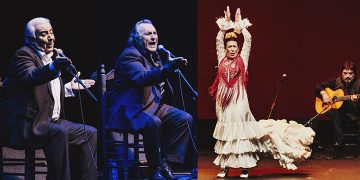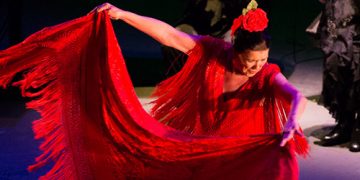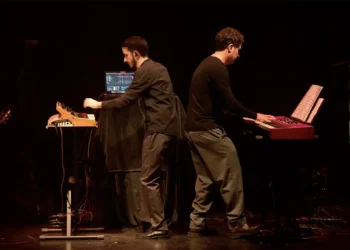|
‘FLAMENCO UNIVERSAL’ |
|
SPECIAL BIENAL DE FLAMENCO DE SEVILLA 2008 Text: Estela Zatania Dance: Pepa Montes, Abel Jarana, Jesús Ortega. Guitar: Ricardo Miño, Paco Vargas. Cante: Enrique Soto, Vicente Gelo, Sebastián Cruz. Percussion: Juan Ruiz, David Chupete. Violin: Bruno Axel “El Duende”. Guest artist: Pedro Ricardo Miño (piano). Seville dancer Pepa Montes and her guitarist husband Ricardo Miño, belong to that generation of flamenco artists who got left holding the bag when the dynamic team of Camarón/Paco de Lucía turned over the game-board and changed the rules. Too deeply into their careers to change course, and too young to retire, there was no choice but to blindly move forward, in the hopes that there would continue to be a demand for the classic flamenco their knew so well. Many fine professionals fell by the wayside while attempting to modernize, others clung to their classic roots and managed to maintain a modest but dignified career. Miño was one of the first to toy with fusion in the early seventies, incorporating Gualberto’s sitar, but younger artists practiced fusion more aggressively, and those timid feelers were all but forgotten. Pepa followed her classic line of dance in the Seville style of Matilde Coral, with occasional attempts, mostly unsuccessful, at renovation. All the while, the couple’s son, pianist Pedro Ricardo Miño, became part of the equation, and there was the practical need to bring the family together in the same show. Pepa Montes won a prize in Córdoba in 1975, a year that could be cited as the demise of the neoclassic era, when the so-called “new flamenco” began its meteoric ascent. So what are the options for a dancer who reached artistic maturity at the precise moment the art-form she learned to dominate began its decline? This is the dilemma unintentionally faced by Pepa Montes in “Flamenco Universal”, with uneven results, and with as many good moments as dreadful ones. If a few years ago she was practicing an outdated tablao style, now, her own background in traditional flamenco makes the overload of theatrical elements in this show inappropriate. What Pepa Montes needs to do is dance, period. Because it’s what her admirers want, because it’s what she does best and because an artist resides within her. The opening number of “Flamenco Universal” is a sort of anthology where we see the dancer moving through tonás, serranas, abandolao and soleá, a potpourri whose excessive length, about a half hour, is tiresome. Conventional theater wisdom says opening numbers should be brief and not too dense – good advice. A farruca to piano with two male dancers, Abel Jarana and Jesús Ortega, appears on the program as “Gades…¡Maestro!” The minor key and naturally heavy-handed rhythm lend themselves to the sound of the piano which even includes the “escalera”, that diabolic surge of notes that used to be guitarists’ worst nightmare until it went out of fashion. A caña, first to piano and then with cante, guitar and dance, “En el Recuerdo a Pilar López”, follows the most classic model, with Sabicas falsetas included. Following this, Ricardo Miño toys with pizzicato, a technique gutarist Rafael Rodríguez has turned into a small fad, and a strange take on garrotín with almost no cante is offered. This nearly obsolete form, normally characterized by a light-hearted spirit, has here the specific gravity of a siguiriya, supposedly intentionally so. A violinist wearing a magician’s top-hat is embarrassingly out of place, but then, we are permitted some bulerías moments full of flamenco energy, followed by Pepa’s cantiñas with bata de cola. One can easily see that she is from a generation for whom the bata was a basic accessory, not to be used as a circus trick. And so finally we get to see the dancer, Enrique Soto sings without guitar, and you leave the theater wondering what need there was for everything that preceded these choice moments. |



 XV BIENAL DE FLAMENCO DE SEVILLA
XV BIENAL DE FLAMENCO DE SEVILLA 


















